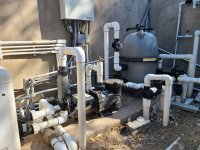I am working with a Jandy VSP ePUMP VSSHP270AUT 2.7HP and PLC1400 SWCG.
Out of curiosity (trying to prove very low speed may have been causing SWCG scaling) I am trying to dial in the RPM of the motor to achieve the 20GPM minimum specified in the manual for the PLC1400 SWCG. So I also installed a FlowVis Flow Meter (to read GPM) in between the filter and heater. I got it for free, so figured I may as well install it.
Here is the weird part. When I set the motor to 2100rpm it will start reading anywhere from ~358-367watts and the Flow Meter will read 19-20GPM for the first 10-15minutes of running, but then over the course of 30-60minutes (I'll take readings every 10minutes), the wattage will slowly start decreasing (along with the GPM) and end up at a random wattage anywhere between ~338-350watts, 15-29watts less than it started. This usually leads to a GPM anywhere from 12 to 17 GPM and seems totally random where it ends up throughout the day. Its kind of annoying when I can pick an RPM and it hits 20GPM for 10minutes, but then when I come back hours later it could be operating at 12GPM or 17GPM.
Besides the oddity of the decreasing wattage, I wouldn't think a 15-30 wattage reduction could contribute up to a 8GPM decrease when the pump initially reads 20GPM. A 8GPM drop from 20GPM is 40%, but a wattage decrease from 367w to 338w is only 7%. How does a 7% decrease in power reduce GPM by 40%? This all seems a little curious.
Is the pump/controller/etc working as expected? If so then I imagine I will just need to pick a higher RPM so it settles somewhere in the 20GPM range after running for an hour?
Southern California energy pricing is crazy, so I want to dial in my pool/life to be as efficient as possible It initially started with odd SWCG scaling, now I am down this rabbit hole... hahaha
It initially started with odd SWCG scaling, now I am down this rabbit hole... hahaha
Out of curiosity (trying to prove very low speed may have been causing SWCG scaling) I am trying to dial in the RPM of the motor to achieve the 20GPM minimum specified in the manual for the PLC1400 SWCG. So I also installed a FlowVis Flow Meter (to read GPM) in between the filter and heater. I got it for free, so figured I may as well install it.
Here is the weird part. When I set the motor to 2100rpm it will start reading anywhere from ~358-367watts and the Flow Meter will read 19-20GPM for the first 10-15minutes of running, but then over the course of 30-60minutes (I'll take readings every 10minutes), the wattage will slowly start decreasing (along with the GPM) and end up at a random wattage anywhere between ~338-350watts, 15-29watts less than it started. This usually leads to a GPM anywhere from 12 to 17 GPM and seems totally random where it ends up throughout the day. Its kind of annoying when I can pick an RPM and it hits 20GPM for 10minutes, but then when I come back hours later it could be operating at 12GPM or 17GPM.
Besides the oddity of the decreasing wattage, I wouldn't think a 15-30 wattage reduction could contribute up to a 8GPM decrease when the pump initially reads 20GPM. A 8GPM drop from 20GPM is 40%, but a wattage decrease from 367w to 338w is only 7%. How does a 7% decrease in power reduce GPM by 40%? This all seems a little curious.
Is the pump/controller/etc working as expected? If so then I imagine I will just need to pick a higher RPM so it settles somewhere in the 20GPM range after running for an hour?
Southern California energy pricing is crazy, so I want to dial in my pool/life to be as efficient as possible


